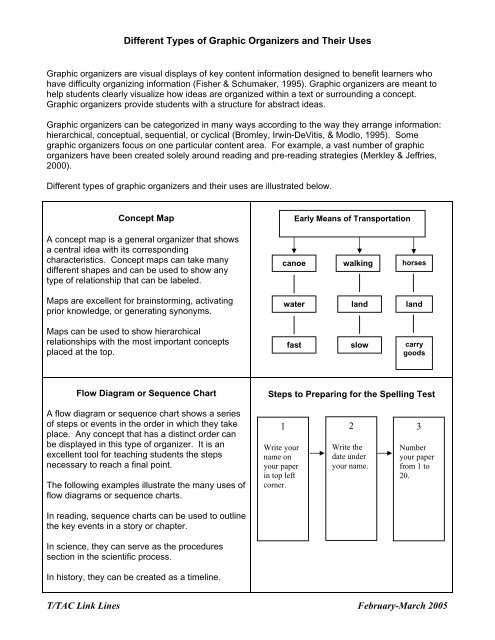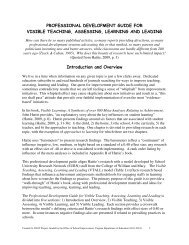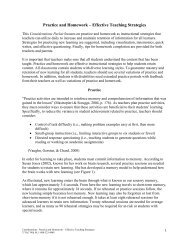Different Types of Graphic Organizers and Their Uses
Different Types of Graphic Organizers and Their Uses
Different Types of Graphic Organizers and Their Uses
Create successful ePaper yourself
Turn your PDF publications into a flip-book with our unique Google optimized e-Paper software.
<strong>Different</strong> <strong>Types</strong> <strong>of</strong> <strong>Graphic</strong> <strong>Organizers</strong> <strong>and</strong> <strong>Their</strong> <strong>Uses</strong><br />
<strong>Graphic</strong> organizers are visual displays <strong>of</strong> key content information designed to benefit learners who<br />
have difficulty organizing information (Fisher & Schumaker, 1995). <strong>Graphic</strong> organizers are meant to<br />
help students clearly visualize how ideas are organized within a text or surrounding a concept.<br />
<strong>Graphic</strong> organizers provide students with a structure for abstract ideas.<br />
<strong>Graphic</strong> organizers can be categorized in many ways according to the way they arrange information:<br />
hierarchical, conceptual, sequential, or cyclical (Bromley, Irwin-DeVitis, & Modlo, 1995). Some<br />
graphic organizers focus on one particular content area. For example, a vast number <strong>of</strong> graphic<br />
organizers have been created solely around reading <strong>and</strong> pre-reading strategies (Merkley & Jeffries,<br />
2000).<br />
<strong>Different</strong> types <strong>of</strong> graphic organizers <strong>and</strong> their uses are illustrated below.<br />
Concept Map<br />
A concept map is a general organizer that shows<br />
a central idea with its corresponding<br />
characteristics. Concept maps can take many<br />
different shapes <strong>and</strong> can be used to show any<br />
type <strong>of</strong> relationship that can be labeled.<br />
Maps are excellent for brainstorming, activating<br />
prior knowledge, or generating synonyms.<br />
Maps can be used to show hierarchical<br />
relationships with the most important concepts<br />
placed at the top.<br />
Flow Diagram or Sequence Chart<br />
A flow diagram or sequence chart shows a series<br />
<strong>of</strong> steps or events in the order in which they take<br />
place. Any concept that has a distinct order can<br />
be displayed in this type <strong>of</strong> organizer. It is an<br />
excellent tool for teaching students the steps<br />
necessary to reach a final point.<br />
The following examples illustrate the many uses <strong>of</strong><br />
flow diagrams or sequence charts.<br />
In reading, sequence charts can be used to outline<br />
the key events in a story or chapter.<br />
In science, they can serve as the procedures<br />
section in the scientific process.<br />
In history, they can be created as a timeline.<br />
Early Means <strong>of</strong> Transportation<br />
canoe walking horses<br />
water l<strong>and</strong> l<strong>and</strong><br />
fast slow carry<br />
goods<br />
Steps to Preparing for the Spelling Test<br />
T/TAC Link Lines February-March 2005<br />
1<br />
Write your<br />
name on<br />
your paper<br />
in top left<br />
corner.<br />
2<br />
Write the<br />
date under<br />
your name.<br />
3<br />
Number<br />
your paper<br />
from 1 to<br />
20.
Compare/Contrast or Venn Diagram<br />
A compare/contrast or Venn diagram is used to<br />
identify the similarities <strong>and</strong> differences between<br />
two or more concepts. The most commonly used<br />
organizer, this instructional tool is found in<br />
textbooks, on st<strong>and</strong>ardized tests, <strong>and</strong> in teacher<br />
resource materials.<br />
Cause-<strong>and</strong>-Effect Diagram<br />
A cause-<strong>and</strong>-effect diagram highlights the direct<br />
relationship between different events or concepts.<br />
This tool is one <strong>of</strong> the most beneficial organizers<br />
because <strong>of</strong> its many applications in all subject<br />
areas.<br />
For example, this diagram might be used to<br />
analyze characters <strong>and</strong> events in reading, to<br />
discuss major events in social studies, or to study<br />
the impact <strong>of</strong> a science experiment.<br />
Main Idea <strong>and</strong> Details Chart<br />
A main idea <strong>and</strong> details chart shows the<br />
hierarchical relationship between major concepts<br />
<strong>and</strong> their subordinate elements. This organizer is<br />
extremely beneficial in helping students<br />
distinguish central ideas <strong>and</strong> their corresponding<br />
details from less important information.<br />
When using the type <strong>of</strong> graphic organizer, clearly<br />
label the main idea <strong>and</strong> the details as such. Use a<br />
different shape or area for the main idea <strong>and</strong> the<br />
details.<br />
Character Comparison<br />
Bill Both Kendra<br />
Happy<br />
Smart<br />
4 siblings<br />
Baseball player<br />
Causes Effects<br />
It did not<br />
rain for 3<br />
weeks<br />
The<br />
temperature<br />
was 100<br />
degrees<br />
Main Idea<br />
Thomas<br />
Jefferson<br />
was an<br />
important<br />
Virginian.<br />
In the 4 th grade<br />
Watch “Rugrats”<br />
Like to read<br />
Math is favorite<br />
subject<br />
The<br />
flower<br />
died<br />
Main<br />
Event<br />
Details<br />
He wrote the<br />
Declaration <strong>of</strong><br />
Independence.<br />
The bee<br />
could not<br />
find nectar<br />
The plant<br />
did not<br />
reproduce<br />
He was the third<br />
president <strong>of</strong> the<br />
United States.<br />
He founded<br />
the University<br />
<strong>of</strong> Virginia.<br />
Wears glasses<br />
Basketball player<br />
2 dogs<br />
Pretty<br />
This is an excerpt from the Considerations Packet <strong>Graphic</strong> <strong>Organizers</strong>: Guiding Principles <strong>and</strong> Effective Practice<br />
prepared by Brad Baxendell, July 2003. To order this packet, visit our website at www.wm.edu/ttac <strong>and</strong> click on<br />
the “Considerations Packets” link.<br />
T/TAC Link Lines February-March 2005



![Full Version [pdf] - School of Education - College of William and Mary](https://img.yumpu.com/21009196/1/190x245/full-version-pdf-school-of-education-college-of-william-and-mary.jpg?quality=85)













